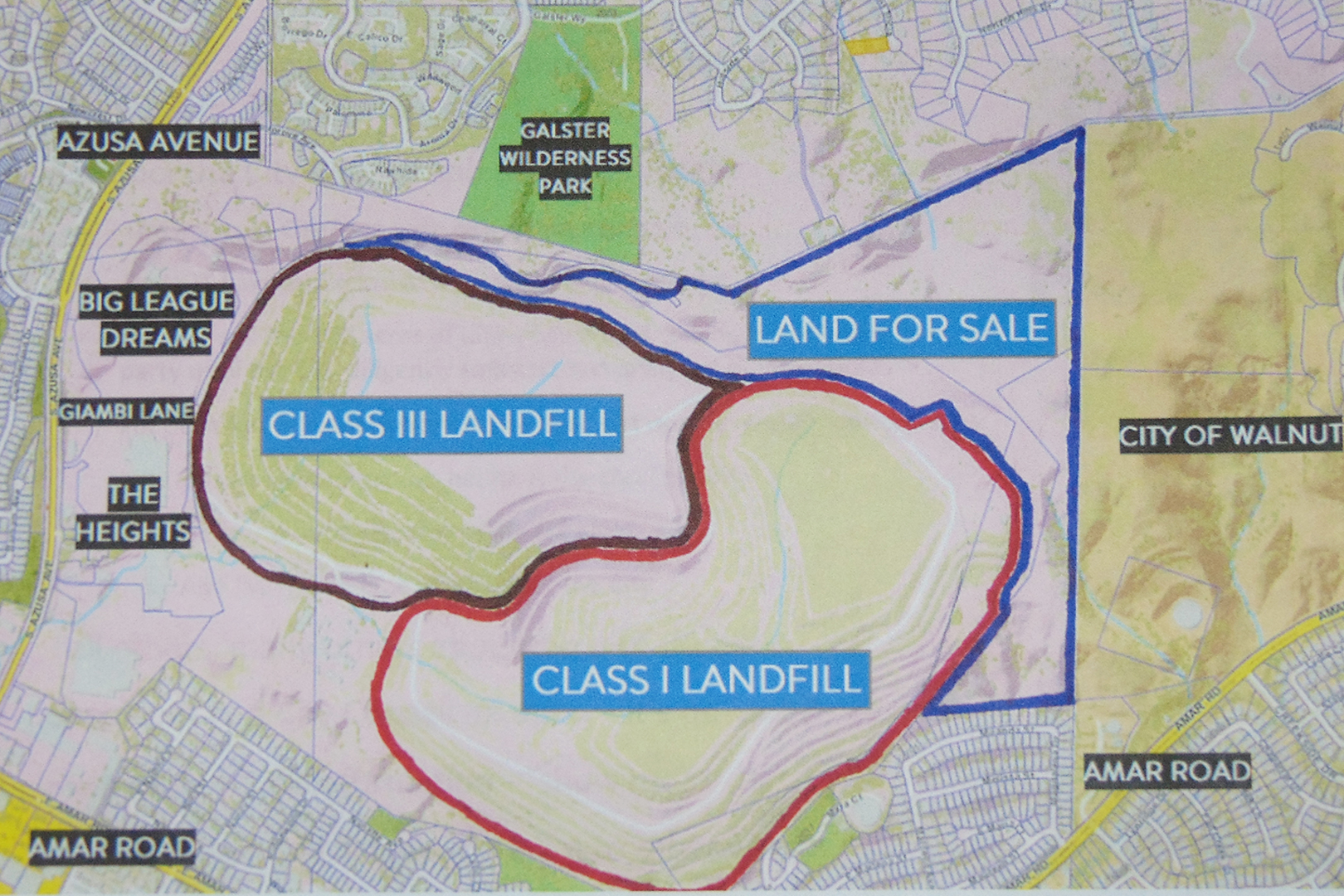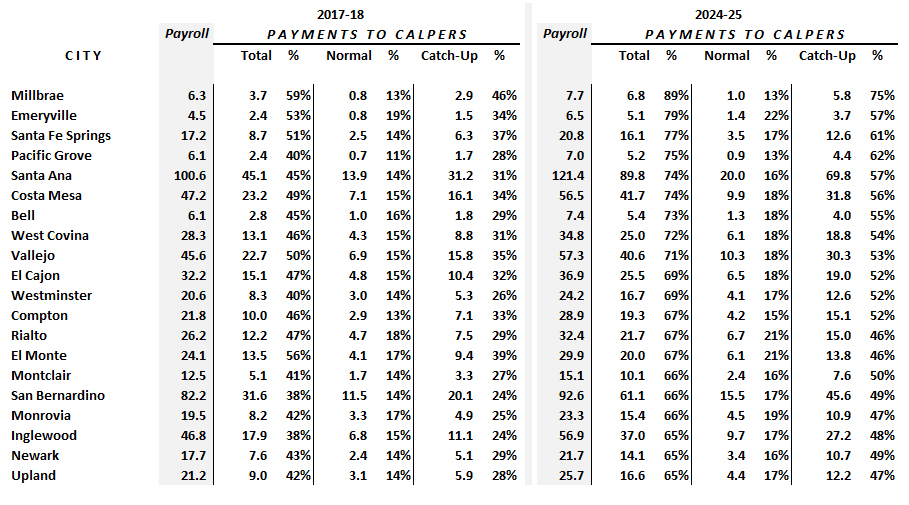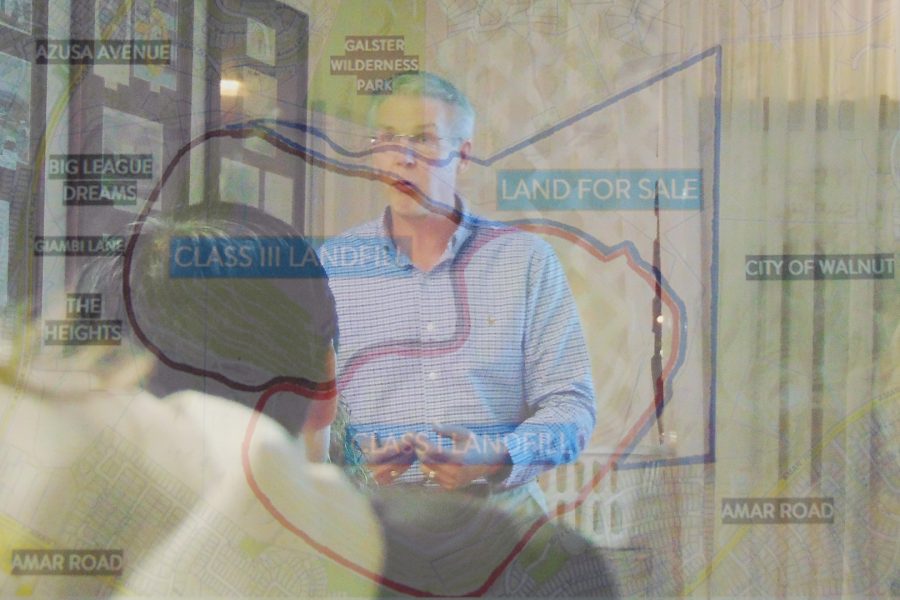There’s a lot of confusion and interest in the BKK Landfill. The information regarding the tract of land has been divided among all news outlets, court documents, and city council meetings.
One man pieced it all together for West Covina residents in less than two hours.
On Nov. 29, the West Covina Improvement Association in coordination with the Historical Society of West Covina hosted Brian Jobst at the society’s museum.
Jobst is a 29 year resident who has lived 10 years in a house 1,500 feet from the landfill. He is also the co-founder of Liveable West Covina and is a management consultant by trade.
He evaluates sites professionally, and used the same techniques while aggregating this data from the previous litigation associated with BKK, archived city council meetings, and the following eight regulatory agencies:
United States Environmental Protection Agency,
United States Army Corps of Engineers,
United States Fish and Wildlife Service,
California Department of Fish and Wildlife,
California Department of Toxic Substances Control,
California Department of Resources Recycling and Recovery,
South Coast Air Quality Management District,
Los Angeles Regional Water Quality Control Board.
To understand BKK better, Jobst said to think of the landfill in three parts. In a diagram that was passed out before the meeting, BKK is divided into a Class I landfill, Class III landfill, and land for sale.

A Class III landfill is meant for regular municipal trash. This is where everyday garbage goes, and it is generally unlined without hazardous waste. Trash from this landfill may break down into leachate, but hazardous materials are designated for Class I and Class II landfills.
The Class I toxic waste has a buffer region, and that buffer region is the land for sale. Previous buffer regions, where Big League Dreams and “the Heights” shopping center are located were developed on, but these developments bordered the “regular” Class III trash dump.
Further, each tract of land has a combined mixture of properties from each section, and the exact boundaries are unknown as this data uses the best approximates from litigation and council meeting records. The land for sale has portions of hazardous and non hazardous waste, the hazardous waste has sections of regular trash and untouched space, and the regular trash segments has untouched space and hazardous waste.
Jobst would later point out that comparing any part of BKK to other landfills just is not a one to one comparison, describing BKK as its own animal.
Landfills are not all the same, but this landfill does not even follow the average or common characteristics and dimensions of a landfill.
The Class III section, regular trash, makes up 175 acres and 20 million tons. To help visualize this amount, Jobst compared it to four of the pyramids of Giza which average about five million tons each.
Four pyramids of five million ton nontoxic waste just above the busiest intersection in the city (Amar Road and Azusa Avenue, according to a 2016 traffic study), and parallel to the most heavily trafficked street in the city (Azusa Avenue, same study) dumped in the ground.
The Class I section, hazardous material, makes up 195 acres and 3.4 million tons. This is mostly comprised of liquids, and unlined – where most landfills are lined today.
To conceptualize 3.4 million tons of liquid, Jobst compared it to 18.3 million bathtubs of water, whereas if someone took a bath every day of their life, they would only reach around 31,000 full bathtubs.
If bathtubs are too hard to conceptualize, Jobst also mentioned the Bellagio fountains in Las Vegas. This amount of toxic waste could fill 42 of them.
An incomplete list of just some of the toxic material include acids, arsenic, cyanide, lead, mercury, cleaning solution, acetone, heavy metal plating solution, paint waste, oil sludge, gasoline and PCBs.
Even worse this is 595 feet deep, so the landfill is not only just large in acreage, but also depth.
To conceptualize this for residents of West Covina, the largest building in the city is the 160 foot tall Eastland Tower on Barranca. The landfill is 3.7 times taller than that tower in depth.
But those are heights and dimensions, merely conceptual figures.
How figures can help to understand this situation, is to use everyone’s favorite comparison, the Industry Hills Landfill now known as the Industry Hills Golf Club at Pacific Palms Resort.
That name is a lot prettier than the BKK dump, but the land it is on is also easier to work with. Jobst explained that a comparison to this facility and Singpoli’s proposed plans would not be one to one.
The Industry Hills Landfill is a typical landfill at only 35 feet deep, but it was also 155 acres, 3.8 million tons, and had zero toxic waste.
That is equivalent to neither tract of land at the BKK landfill.
The Class I section of hazardous waste is 40 acres more, 0.4 millions tons less, and 560 feet deeper.
The Class III section of regular trash waste is 20 acres more and 16.2 million tons more.
Those are differences in just dimensions alone, not even taking into consideration how everything is integrated in that area so that there are hazardous waste materials throughout it.
That does not even factor in that a structure on the Industry Hills land partially collapsed, and that most of the development at Industry Hills was on non landfill land.
To the argument of “it’s just dirt,” Jobst brought up the wildlife that uses the land as their home.
The protected Coastal Sage Scrubs and the endangered California Gnatcatcher inhabit this land. The Gnatcatcher sounds more like a tiny cat meowing, according to Jobst.
There are certain undisturbed swaths of lands that are home to three other endangered birds and a butterfly that also live in the land for sale.
While the argument for protecting wildlife might not be as convincing to some, the BKK landfill is part of a corridor that connects to the nature from West Covina to Walnut, Mt. SAC, Cal Poly Pomona, and Pomona.
Their ecosystems will also be affected by any changes, and what happens to the BKK land is also of interest to the neighboring cities.
Jobst still made the argument that there is significant reason for the 600 acres of land to remain undeveloped for 22 years, even though it is appraised at $6.38 million.
“It’s not a panacea,” he said and repeated.
That was all just description of the land itself, not even considering Singpoli’s proposition
Singpoli’s proposal included a 270 room hotel with a 20,000 square foot conference area, 1,400 race horse stalls, two tracks to train horses one grass and one dirt, employee dormitory for 400 employees, solar greenhouses with hydroponic beds, police canine training center, firefighter training center (that one council member said they want to become a substation), and a “virtual reality park” because Jobst said no one can describe the park.
This proposal was made in December of last year, but in February of this year Singpoli met with four of the regulatory agencies.
Jobst said he does not know how it will change, but that he knows the proposal will change.
He further outlined reasons why the Singpoli proposal does not make sense.
The DTSC and EPA said no permanently habitable structures allowed in the deed restriction, and Jobst asked whether the structures presented counted as permanently habitable structures.
He said he received six yesses that those structures are considered as such.
Jobst further said that deed restrictions can be changed, but that they are there for a reason.
He also brought up other issues including how significant earth work has health risks, one entrance and exit is a safety risk, traffic congestion from horses and visitor traffic onto Azusa Avenue will worsen the traffic situation, and how wildlife agencies and other agencies will put further restrictions on the project.
Horse racing closed in Hollywood park and horse racing is declining, and Jobst said he questioned that as a focus of the plan. Residents at the previous city council meeting focused more on the smell than the decline of the industry.
Litigation against the plan is also likely, as residents of West Covina in the surrounding area and the surrounding cities affected may organize to challenge and oppose it.
The timing is another issue. It was a challenge to balance the budget, and West Covina was ranked the eighth worst city in the entire state in regards to having the highest proportion of available budget as a city to fund unfunded pension liability and existing liabilities.

To those thinking that money will be rolling in no time, Jobst warned about the development timeframe.
He pegged a timeframe of seven to 10 years, but said that Singpoli themselves said in a city council meeting that it would take three to four years for construction alone.
Similar developments have taken four to six years to complete. Jobst added that the result of whatever happens with the financial status of West Covina will likely be worked out by then.
Further adding delay to any start of construction, is the need for an environmental impact study and the issuance of a National Pollutant Discharge Elimination System permit.
Even that ignores the two recent pushes for buildings in zoned land.
Porto’s Bakery was first discussed in 2010, and it took until fall of this year to be finalized and built. That bakery was a 21,000 commercial building in a site zoned for it with everything in place.
Eight years for a building that did not require a permit or study.
Another individual has been trying to put seven condos in his plot, and has been very agreeable to the council’s requests despite being in a lot zoned for the work. The developer’s representative’s pointed out that he was five years in to try and get the condos built and he does not have plans.
These two buildings are nowhere near the scale of this project and have had significant time delays.
Further Jobst said the revenue would be a four percent bump, only raising $3.6 to $4 million a year, and clarified that he was not anti development.
Jobst said that he understands the lucrative nature of the hotel occupancy tax rate gives 100 percent to the city, where property taxes are only garner the city 16 cents on the dollar, but cautioned about future occupancy.
For hotel occupancy, Singpoli proposed 270 rooms, but Mayor Pro Tem Tony Wu proposed 400 rooms.
The kicker is, a city analysis found that there is only an efficient demand for 137 new hotel rooms by 2035, and the city only gets the money if the rooms are filled.
Even Starwood, the owner of the Plaza Mall, wants to redo the mall to include a hotel, but has not produced finalized plans yet. Jobst even argued that this was a better location off the freeway, and would take from the potential hotel on the BKK dump.
When asking how to pick a hotel, Jobst said you pick the destination first before picking the hotel, and asked what would draw people to the hotel on BKK.
One resident quickly responded, “The smell.”
Another concern Jobst explained was bond refinancing.
The West Covina City Council refinanced $19.45 million in bonds on September of this year. This involved the refinanced $9.4 million principal of the $13 million owed on a failed golf course attempt.
This breaks down into $4.17 million in taxable bonds that mature 2044, and $5.23 million in tax-exempt callable bonds that mature in 2029.
Selling the land at $6.3 million still would not cover the $9.4 million outstanding.
While he spent all this time outlining his concerns, Jobst said it was important to provide solutions.
He offered that the council pursue a different process.
This would involve seeking public input, issuing an Request For Proposals, and getting out of this one developer one idea concept by going to a non-binding agreement.
Another idea would include adding a park and solar panel, selling 122 acres of the land to a conservation interest resulting in $6.38 million to the city. The party sold to would create a park, trails, and other events.
Jobst said he could not get too much information about solar because the market considers the land sold with that agreement currently in place, but that could be an avenue for the money to profit off the land.
Finally, he advocated for everyone in attendance to spread the word to the city council, neighbors and everyone involved.
Mayor Lloyd Johnson and council member James Toma were in attendance at this session.
Johnson had arrived early to the event and told residents that he wanted to hear all sides and has an open mind. Regarding Singpoli, he said he found out about the company through Wu and did know about them otherwise.
“What’s important to you guys is important to me,” Johnson said before the event started.
After the information session concluded, Johnson said he found it “very enlightening” and added that he learned some stuff he did not know at the meeting.
This was Jobst’s third presentation, and the first time council members have gotten all of the information in one session, instead of bits and pieces.
The next presentation by Brian Jobst is on Dec. 13 from 6:30 to 8:30 p.m. at the West Covina Library.
This item was removed from the consent calendar of the Nov. 20 council meeting, and has been put on the agenda for the Dec. 18 meeting.
Correction; Dec. 15, 11:50 a.m.:
It was previously reported that: “This breaks down into: $4.17 million in taxable bonds that mature 2044, but cannot be payed off until 2028, with a clause that says even if land is sold, this portion of the bond cannot be paid off until 2028. $5.23 million in tax-exempt callable bonds that mature in 2029. Only the second set can be paid sooner.”
After city manager Chris Freeland provided input on one of Brian Jobst’s presentations, this information was updated accordingly in subsequent presentations.
For clarity and accuracy this article has been updated to reflect the change: “$4.17 million in taxable bonds that mature 2044, and $5.23 million in tax-exempt callable bonds that mature in 2029.”
If any other discrepancies are found they will also be changed when discovered.



